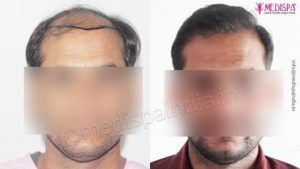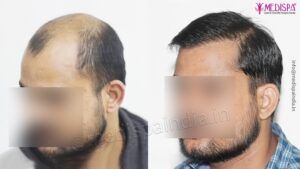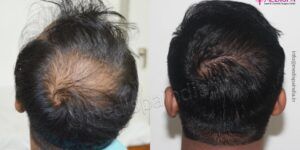
Hair restoration surgery is performed on patients who have bald spots on their scalps as well as in facial hair, such as the beard, moustache, and brows. This minimally invasive procedure aims to implant hand-selected hair follicular grafts from permanent hair root bearing areas. Permanent hair roots can grow in particular on the sides and back of the head, as well as on body hairs that are not on the scalp.
Jaipur is known for its hair transplant business in addition to its well-known tourism attractions that bring tourists from all over the world. Nowadays, tourists visit Jaipur for two purposes: to admire the beauty of the city and to get the best hair transplant in Jaipur. In the city, there aren’t many well regarded hair transplant surgeons with more than ten years of experience.
Medispa Hair Transplant Clinic has been a pioneer in the field for more than a decade. Celebrities, local patients, and patients from foreign countries all individually choose us because of our expertise in this field and the hundreds of success stories we have. Our exceptional results and high-quality treatments offered at a reasonable hair transplant cost in Jaipur has earned us recognition and respect across the world. Nearly all of our clients express their gratitude for our friendly staff’s high level of commitment, knowledge, and passion. They also express gratitude for their good acts, which provide a pleasant touch to their excellent work.
What is Hair transplant?
A minimally invasive restoration process known as a hair transplant involves the removal of follicular grafts from the donor region based on the density of available hair, followed by their implantation at the recipient bald area. It’s a common misconception that a hair transplant involves using fake hairs or someone else’s hairs. In contrast to this, the method employs your own hairs that are taken from other places with abundant hair density. Grafts are the name given to these extracted hair follicles.
What are grafts?
Grafts are tissue pieces that have hair follicles in them that are taken from a safe, higher density donor area and then transplanted into a suitable recipient location that is bald. These grafts are solely taken from the DHT resistant, safe donor region and are meant to last a lifetime and produce long-lasting benefits.
After undergoing a hair transplant, you can acquire a pleasing appearance, but you shouldn’t hold out hope for a head covered in hair. As each transplanted hair follicle needs its own blood supply for nourishment to grow, hair transplants can only restore up to 30% of the lost hair density. This can only attract a limited number of hair follicles because it is impossible to deliver blood to 100% of them.
FUT and FUE are the two main methods used to harvest grafts for hair restoration. The quantity of grafts needed for the treatment is a crucial factor in determining whether a patient chooses to use these procedures.
A hair graft calculator is meant to help you estimate the approximate number of hair follicles needed for your hair transplant. During the initial meeting, the hair transplant surgeon makes a definitive determination on the necessary number of follicles. An online hair transplant calculator is accessible on the official Medispa clinic website that estimates the number of grafts required per square cm of baldness.
How many grafts are needed?
The number of grafts required for your hair transplant will be determined by your hair transplant surgeon using a number of factors, including:
- Level of baldness: Norwood’s classification only takes level of baldness into account when calculating the number of grafts required to cover the bald region. The greatest quantity of hair grafts is needed in advanced Norwood VI and VII baldness patients.
- Availability of hair density in the donor region: The number of follicular grafts that can be collected from the donor site relies on the area’s hair density. To avoid overharvesting or density depletion at the donor site, it is important to carefully determine how many grafts will be removed. Care should also be taken to just include the safe donor location in order to ensure enduring results.
- Hereditary baldness: Hair follicle counts should be done with extra caution in those with pattern baldness who have a family history of hair loss due to a family history of severe baldness. One session’s hair follicles are picked with future hair transplant procedures and thinning hair in mind.
- Experience of the Surgeon: More experienced surgeons will surely carry out the treatment more successfully and with fewer botched follicular transplants. Follicular transplants must have a higher survival rate for the patient’s long-term benefits and to cover balder regions. On the other hand, inexperienced surgeons purposely pre-harvest more follicular transplants to make up for the grafts they lose or damage. You run the risk of losing vital hair follicles that may have made your hair transplant successful if you do this.
- Setting clear expectations: It is important to inform the patient at the beginning of the consultation about the expected outcomes as it will help to assure their total satisfaction. To do high density hair transplants, which are becoming increasingly popular nowadays, the donor area must be adequately thick. Setting the lowest possible expectations up front is typically best.







